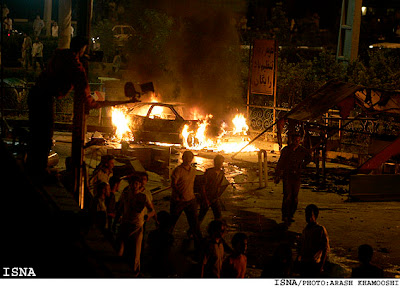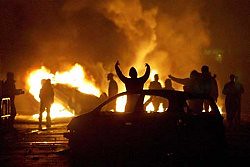General Petraeus gave an interview with Chris Wallace over at Fox News this Sunday. I can already imagine the vapors some people are getting into from reports such as this.
Asked whether he thought the job assigned to an additional 30,000 troops deployed as the centerpiece of President Bush’s new war strategy would be completed by then, Gen. David H. Petraeus replied: “I do not, no. I think that we have a lot of heavy lifting to do.”
Of course, the General (IIRC) didn’t say things would be over by September, only that he was confident he would be able to give a realistic assessment of the progress of the new tactics by then. He was cautioning people, as he is still doing, not to prematurely judge our efforts there.
WALLACE: There are reports that you and General Odierno would like the surge to continue until at least early 2008, that if it’s going to work, it needs to continue into early next year. Is that true?
PETRAEUS: We’ve got a number of different options that we have looked at, Chris, and it really is premature at this point in time to try to prejudge that.
Again, I would suspect that late in the summer, early September, that we will provide some recommendations on the way ahead up our chain of command as well.
WALLACE: But you surely don’t think the job would be done by the surge by September, do you, sir?
PETRAEUS: I do not, no. I think that we have a lot of heavy lifting to do. The damage done by the sectarian violence in the fall and winter of 2006 and early 2007, as I mentioned, was substantial. And this is a tough effort.
WALLACE: So then it would be fair to assume that the enhanced troop levels would continue for some months after that and into 2008.
PETRAEUS: Chris, again, premature right now. A number of options out there. And not about to announce what we might do here today, I’m afraid.
WALLACE: Well, you can’t blame me for trying, sir. There are also some…
(LAUGHTER)
WALLACE: There are also some reports that you believe that we’re going to need at least 130,000 troops in Iraq through the end of 2008. Is that true?
PETRAEUS: Chris, there’s some wonderful mind-readers out there. I’d love to know who they are. But they seem to know what’s in my mind better than I do.
Again, our first focus is on doing all that we can as we’ve truly now launched the surge and we have some reasonable expectations for what we can achieve.
Beyond that, we will obviously provide that assessment in September along with, I would suspect, at that time some recommendations on the way ahead. But you’re looking out well beyond that, and we’re not prepared to address that yet.
WALLACE: Well, let me look out even further than that, General. Some administration officials have talked about needing to make — and basically squaring with the American public, saying, “Look, this is going to be a long-term commitment,” and even comparing it to the situation in South Korea, where we have had thousands of troops for decades.
Do you see this to stabilize and achieve what we want in Iraq as that kind of a long-term commitment?
PETRAEUS: Well, I think the real question, Chris, is at what level. I think just about everybody out there recognizes that a situation like this, with the many, many challenges that Iraq is contending with, is not one that’s going to be resolved in a year or even two years.
In fact, typically, I think historically, counterinsurgency operations have gone at least nine or 10 years.
The question is, of course, at what level, how much will we have to continue to contribute during that time, how much more can the Iraqi security forces and the Iraqi government pick up as this goes along. And I think that’s the real question. And I’m not sure what the right analogy is, whether it’s Korea or what have you.
I think all that the folks in Washington were trying to indicate by that was that there is some possibility of some form of long-term security arrangement over time.
And I think in general that that’s probably a fairly realistic assessment, assuming that the Iraqi government, in fact, does want that to continue. And of course, it is very much up to them, and their sovereignty is paramount in all of this.
So, we may be there for years. But as always, it is what level of violence we face that will determine public opinion about the mission. If the level of violence is low, and progress is being made, America will shuffle behind the effort, except for the die hard “anti-war”, anti-Bush ideologues.
And yes, Petraeus, consistent with earlier statements, only now feels like the operation is beginning. All the pieces are in place, and some major operations are beginning.
WALLACE: This week you finally got your full complement of forces in Iraq. How is the surge working so far? And to some degree, do you feel as if the operation is only now beginning?
PETRAEUS: We actually do. In fact, a lot of what we have done to this point has been so-called shaping operations for what we have just recently launched in the last 48 hours and some additional operations that we’ll launch over the next 48 or so hours.
That’s not to say that we have not used those forces as they have come in, but we just recently got the fifth and final Army surge brigade, the Marine Expeditionary Unit, and our combat aviation brigade, which add considerable combat power.
And they are enabling us now to launch operations into sanctuaries, areas in which we have had very little coalition force presence other than raids in recent years.
These are areas where Al Qaeda has established car bomb factories and other bases from which they have issued forth and then moved into Baghdad to attack targets, often indiscriminately.
Operations such as the following, which Michael Yon writes about in his latest dispatch.
http://www.foxnews.com/story/0,2933,284233,00.html
About 10,000 U.S. soldiers launched an offensive against Al Qaeda in Iraq northeast of Baghdad early Tuesday, killing at least 22 insurgents, the U.S. military said.
The raids, dubbed “Operation Arrowhead Ripper,” took place in Baqouba, the capital of Diyala province, and involved air assaults under the cover of darkness, the military said in a statement. The operation was still in its opening stages, it said.
Ten thousand U.S. soldiers were accompanied by attack helicopters, Strykers and Bradley Fighting Vehicles, the statement said.
The operation was part of new U.S. and Iraqi attacks on Baghdad’s northern and southern flanks, aimed at clearing out Sunni insurgents, Al Qaeda fighters and Shiite militiamen who had fled the capital and Anbar during a four-month-old security operation, military officials said.
A top U.S. military official said Monday that American forces were taking advantage of the arrival of the final brigade of 30,000 additional U.S. troops to open the concerted attacks.
And for an overview of the operations, there is this report from Bill Roggio…
With the last U.S. combat brigade to hit the ground over the last two weeks as part of the surge, Multinational Forces Iraq has declared the beginning of “major combat operations” in the belts regions surrounding Baghdad. The Baghdad Belts, which included Eastern Anbar, northern Babil, and southern Salahadin and Diyala provinces, has long been a staging area for al Qaeda and insurgent operations into Baghdad, and a key part of the Baghdad Security Plan is denying these regions to the enemy.
In the June 16 briefing given by Defense Robert Gates, General David Petraeus and Ambassador Ryan Crocker, General Petraeus explained that the past four months have set the stage for the “large, coordinated offensive operations” which kicked off over the weekend. The combat, logistics and intelligence pieces have been “put in place over the past several months,” while a clear intelligence picture was developed of the regions surrounding Baghdad. “We have been doing what we might call shaping operations in a lot of these different areas [in the belts], feeling the edges, conducting intelligence gathering, putting in special operators.”
The picture on the Battle of the Belts is still developing. Based on the available open source information, current operations are ongoing to the north, west and south of Baghdad. Multiple U.S. and Iraqi units are operating at the brigade and division level.
There is a lot going on right now. Until these large operations are over, expect US and Iraqi casualties to rise, as we will be in direct contact with the enemy. The enemy to fight back harder. The last throes of a dying animal, or enemy, are often the most viscous. Don’t expect to make sense of it all, or to be able to judge how things are going by any reports from here through September.
UPDATE:
Confederate Yankee tells us something else we should expect:
The “Mahogany Ridge” media is tied up in the latest suicide bombing in Baghdad (simply look at the title, lede, and focus of the CNN article cited above as an example), and even those who chose to feature the Baquba assault clearly don’t understand the magnitude of the just-joined battle.
Once reality slowly dawns on the media that they are misunderestimating the scope and scale of the assault, steel yourself for a rush of inaccuracies as they seek to get something, anything published, much of it based upon rumor, some of it based upon outright propaganda and lies.
We saw the same during and after Fallujah, when the U.S. military was accused of using napalm on civilians. We don’t even have napalm.
The ignorati claimed that white phosphorus was a “chemical weapon,” of a “poison gas” and ascribed horrible wounds to it. These claims turned out to be completely untrue.
There may also once again be claims that using .50-caliber machine guns and the cannons of Bradley IFVs and helicopter gunships against terrorist personnel somehow violates the Geneva Conventions. It doesn’t.
This is one reason why I don’t read the mainstream media to find out about the war, lack of expertise. Just as I don’t read Home & Garden to find out about hot rodding, I choose to find out about military matters from people who’ve been there and done that.
Sphere: Related Content

 Closely following the third assassination of a senior Iranian official in two months, Tehran is suddenly burning. The long smoldering tension between citizens and tyrannical mullahs shows no signs of abating, with the latest development being riots over gasoline-rationing [HT:
Closely following the third assassination of a senior Iranian official in two months, Tehran is suddenly burning. The long smoldering tension between citizens and tyrannical mullahs shows no signs of abating, with the latest development being riots over gasoline-rationing [HT:  the regime has been expecting trouble and tried to head it off.
the regime has been expecting trouble and tried to head it off.
